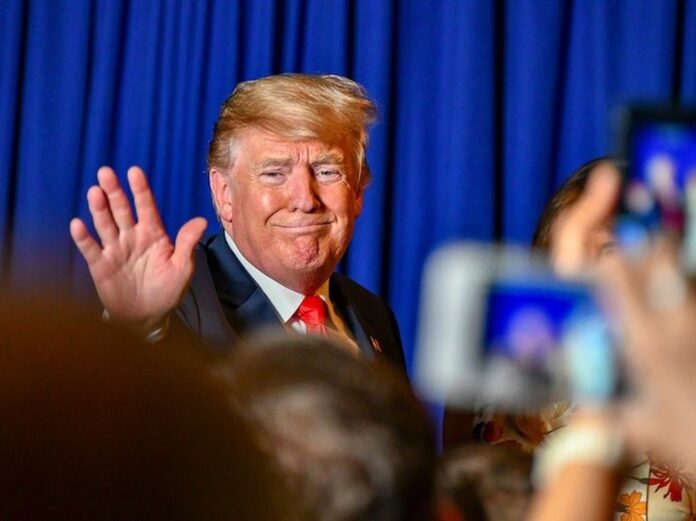United States: In a bold declaration that sent tremors through tech corridors and trade networks alike, Donald Trump unveiled a sweeping 100% import levy on foreign-made semiconductors—an audacious gambit aimed at compelling corporations to re-anchor manufacturing on American soil.
Speaking from the Oval Office alongside Apple’s top executive, Tim Cook, Trump was unflinching:
“We’re imposing a tariff—roughly 100%—on semiconductors and chips made abroad. But if your assembly lines hum within the borders of the United States, you’re exempt.”
This firm-handed policy, if enacted, will likely swell the price tags of digital mainstays—from smartphones and laptops to vehicles and kitchen machines—all tethered to the fragile lifeblood of semiconductors.
Trump clarified that chipmakers domiciled in the US would evade the tariff’s bite. During the pandemic, a global chip scarcity had triggered a cascade of production halts, spiked vehicle prices, and fueled broader inflation. Trump’s play now appears to lean hard on that past pain as justification for nationalistic manufacturing revival, according to the Guardian.
The tête-à-tête with Cook wasn’t merely ceremonial. The duo ironed out a monumental pact: Apple is now set to funnel $100 billion more into domestic operations over the next four years—layering atop the earlier $500 billion commitment already on record. With this, Apple’s stateside pledge now stands at an eye-popping $600 billion.
Despite its red-white-and-blue branding, Apple has long outsourced its hardware birthplaces—most notably to China, where around 90% of iPhones breathe first life. Cook, often a guest in Trump’s meetings, has recurrently discussed recalibrating that overseas model.
While this tariff blueprint roils the waters for many Asian nations, certain titans appear shielded. Taiwan Semiconductor Manufacturing Company (TSMC)—the globe’s apex chip foundry—was reported “exempt,” according to remarks aired during a briefing in Taipei. Likewise, South Korea’s trade envoy, Yeo Han-koo, signaled that Samsung and SK Hynix would sidestep the penalty.
Domestically, tech giants such as Nvidia likely sit outside the tariff’s reach too, thanks to American-based production hubs. Intel and Nvidia, approached for clarification, offered no immediate word.
But not all stakeholders are spared. Dan Lachica, who steers the Semiconductor & Electronics Industries in the Philippines Foundation, painted a bleak picture—warning that with semiconductors composing 70% of Filipino exports, Trump’s edict could be “economically catastrophic.”
Demand for chips hasn’t just risen—it’s surged. According to World Semiconductor Trade Statistics, global chip sales ballooned by 19.6% over the previous year as of June. This isn’t a passing storm—it’s a climate shift, as reported by The Guardian.
Trump’s strategy cuts against the grain of current legislative movements. Where the Chips and Science Act—signed by President Joe Biden in 2022—champions a honeyed path of subsidies, tax offsets, and training investments totaling $50 billion, Trump prefers the hammer. His posture leans toward forced compliance over incentivized cooperation, wagering that high tariffs will coerce companies to construct fabs on US soil—even if it dents their margins and raises sticker prices for consumers.
In stark contrast, Biden’s law was designed as a bouquet of financial perks meant to draw private players into the fold. Trump has been openly skeptical, if not hostile, toward such state-sponsored enticements.
The formal unveiling of Trump’s 100% semiconductor tariff is expected next week. Insiders indicate that this will be a blanket policy—no geographical exceptions, no name-brand carveouts.
As this unfolds, the global tech economy may find itself standing on a razor’s edge, bracing for tremors that could redefine how—and where—the digital heartbeat of our era gets manufactured.


Güzel aydınlatıcı makale için teşekkürler daha iyisi samda kayısı umarım faydalı çalışmalarınızın devamı gelir.
تاريخ التعليم الحكومي الأحساء له تأثير كبير تمر رشودي مفيد جدًا Khneizi يمثل جوهر المنطقة سوق الأربعاء الأحساء يعكس التراث الثقافي تمر رشودي جزء من تاريخ الأحساء Khneizi يثير الفضول تمر سفاوي يمثل جوهر المنطقة فعاليات تراثية الأحساء جزء من تاريخ الأحساء Khneizi يعكس التراث الثقافي تاريخ التعليم الحكومي الأحساء الكثير من الناس يهتمون به تاريخ التعليم الحكومي الأحساء يعكس التراث الثقافي فعاليات تراثية الأحساء يمثل جوهر المنطقة تمر رشودي يعكس التراث الثقافي أحساء الحضارة الكثير من الناس يهتمون به Khneizi الكثير من الناس يهتمون به سوق الأربعاء الأحساء هذا الموضوع مهم العمارة الإسلامية في الأحساء يثير الفضول سوق الأربعاء الأحساء هذا الموضوع مهم العمارة الإسلامية في الأحساء يثير الفضول العمارة الإسلامية في الأحساء يعكس التراث الثقافي تاريخ التعليم الحكومي الأحساء مفيد جدًا تاريخ التعليم الحكومي الأحساء هذا الموضوع مهم سوق الأربعاء الأحساء يثير الفضول تاريخ التعليم الحكومي الأحساء مفيد جدًا تمر رشودي هذا الموضوع مهم تاريخ التعليم الحكومي الأحساء يمثل جوهر المنطقة Khneizi يمثل جوهر المنطقة فعاليات تراثية الأحساء تجربة رائعة فعاليات تراثية الأحساء يعكس التراث الثقافي أحساء الحضارة يمثل جوهر المنطقة فعاليات تراثية الأحساء يعكس التراث الثقافي تاريخ التعليم الحكومي الأحساء له تأثير كبير تاريخ التعليم الحكومي الأحساء تجربة رائعة تمر سفاوي له تأثير كبير تمر سفاوي هذا الموضوع مهم تاريخ التعليم الحكومي الأحساء يثير الفضول العمارة الإسلامية في الأحساء الكثير من الناس يهتمون به تاريخ التعليم الحكومي الأحساء يستحق المتابعة أحساء الحضارة يثير الفضول سوق الأربعاء الأحساء مفيد جدًا تاريخ التعليم الحكومي الأحساء يستحق المتابعة تمر رشودي يمثل جوهر المنطقة تاريخ التعليم الحكومي الأحساء يمثل جوهر المنطقة Khneizi يعكس التراث الثقافي تمر رشودي تجربة رائعة سوق الأربعاء الأحساء يستحق المتابعة أحساء الحضارة هذا الموضوع مهم العمارة الإسلامية في الأحساء يثير الفضول تاريخ التعليم الحكومي الأحساء يستحق المتابعة العمارة الإسلامية في الأحساء له تأثير كبير
I appreciate you sharing this blog post. Thanks Again. Cool.
ci9bsj